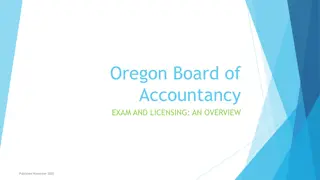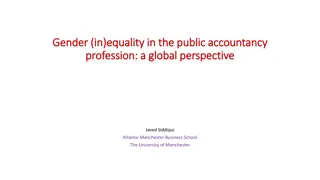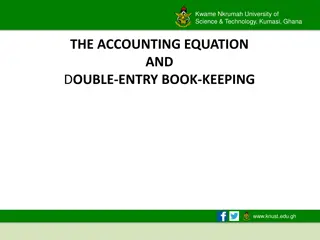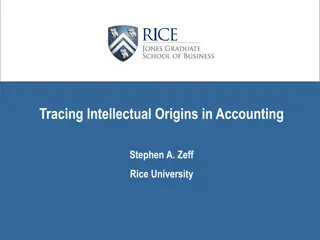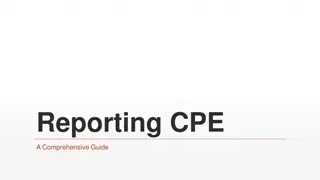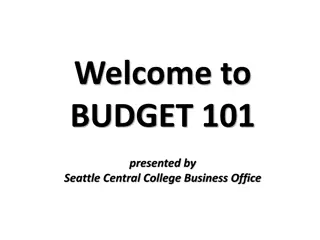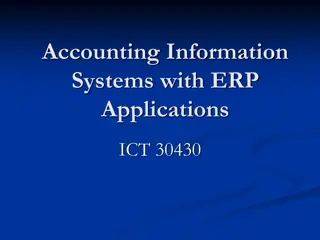Basics of Accounting: Concepts, Book-keeping, and Accountancy Overview
This content covers key concepts in accounting, including the definitions and features of book-keeping, objectives of book-keeping, meaning of accountancy, and branches of accounting such as financial, management, and cost accounting. It emphasizes the systematic recording of business transactions and the importance of interpreting financial information for decision-making.
Download Presentation

Please find below an Image/Link to download the presentation.
The content on the website is provided AS IS for your information and personal use only. It may not be sold, licensed, or shared on other websites without obtaining consent from the author. Download presentation by click this link. If you encounter any issues during the download, it is possible that the publisher has removed the file from their server.
E N D
Presentation Transcript
Accounting concept and convention by Prof. sachin jadhav
Point of discussion Meaning & Definition of Book -Keeping Features of Book - keeping Objectives of Book -keeping Meaning & Definition ofAccountancy Branches ofAccounting Basic accountingTerminologies
Meaning & Definition Book keeping is a process of recording business transitions in the booksof accounts in a very systematicmanner According to J.R. Batilobi: Book Keeping is an art of recording business dealings in aset of books. According to Nocth Cott : Book Keeping is an art of recording in the books ofaccounts the monetary aspects of commercial or financialtransactions.
Features of Book keeping 1 It is the process of recording business transition 2 Monetary transactions are only recorded 3 Recording is made in given set of books of accounts 4 For specific period 5 Art of recording business transactions scientifically
Objectives of Book keeping Permanent record To know the P&L To know the total amount of Capital To know the total assets and liabilities To know the progress of the business To know Legal requirement and tax liabilites
Meaning & Definition of Accountancy Accountancy includes Book keeping & classifying, summarizingand interpreting of the businesstransactions. According to Kohler: Accountancy refers to the entire body of theory and process of accounting. According to Robert N. Anthony: Nearly every business enterprise has an accounting system. Itis a means of collecting, summarizing, analyzing and reportingin monetary terms information about the businesstransactions,
Branches ofAccounting FinancialAccounting ManagementAccounting CostAccounting Journal Ledger Trial balance Final accounts Cost Sheet Job & Contract ProcessCosting Operating Costing Ratio analysis Break even point Standard Costing Analysis of financial S
Basic accounting Terminologies BusinessTransaction Entry & Narration Goods Profit & Loss Assets, Liabilities & Net worth Capital & Drawing Expenditure and types of expenditure Discount Goodwill Bad debts Debtors and creditors Solvent & Insolvent AccountingYear Folio, Insurance, Freight Deposit
BusinessTransaction Any dealing of business that involves buying and selling of goodsand services in exchange of value be called as businesstransaction. Cash Transaction Credit Transactions
Entry, Narration & Goods Entry : Recording of transaction in the proper form or method in the books of accounts is called an entry. It is a first record of any business transaction in the books ofaccounts Narration :Abrief explanation of the business transaction for which an entry is passed is called as a narration. It starts with a word Being ( .) Goods: The commodities or articles in which the trader deals are called as goods for that business
Profit & Loss Profit : Excess of income over the expenses during the accounting yearis called a profit Ex: .. Loss : Excess of expenses over the income is calledloss Ex: ..
Assets, Liabilities & Net worth Assets : Property of any kind owned by a businessman is called anasset, Ex Liabilities : Total amount payable by the business to others is knownas liability Ex .. Net Worth or owned equity : The amount of fund provided bythe proprietor in the business is called as net worth or capitalalso
Types ofAssets Assets : Property of any kind owned by a businessman is called anasset, Ex Fixed Assets : Ex .. Current Assets :Ex .. Fictitious Assets :Ex ..
Accounting concept Accounting principles are those rules which are to be adopted bythe accountants Accounting is the language of business. This are general guidelinesfor sound accountingpractices 1) Reliable financial statements 2) Generally acceptable basis ofmeasurement 3) Valid and appropriate assumptions 4) Uniformity in presentation 5) Valid and appropriate assumptions 6) Proper information to all
Accounting concepts 1) Business entity 2) Money measurement 3) Cost concept 4) Consistency concept 5) Conservatism 6) Going concern 7) Realization 8) Accrual 9) Dual aspect 10) Disclosure 11) Materiality 12) Revenue recognitionprinciple 13) Marching principle 14) Accounting standards
Business entity concept: This concept assumes that, for accounting purposes, the business enterprise and its owners are two separate independent entities. Thus, the business and personal transactions of its owner are separate. For example, when the owner invests money in the business, it is recorded as liability of the business to the owner. Similarly, when the owner takes away from the business cash/goods for his/her personal use, it is not treated as business expense.
Money Measurement concept: This concept assumes that all business transactions must be in terms of money. In our country such transactions are in terms of rupees. Thus, as per the money measurement concept, transactions which can be expressed in terms of money are recorded in the books of accounts
Going concern concept This concept states that a business firm will continue to carry on its activities for an Future period of time. Simply stated, it means that every business entity has continuity of life. Thus, it will not be dissolved in the near future. This is an important assumption of accounting, as it provides a basis for showing the value of assets in the balance sheet.
Accounting period concept: The life of an entity is divided into short economic time periods on which reporting statements are fashioned. All the transactions are recorded in the books of accounts on the assumption that profits on these transactions are to be ascertained for a specified period. This is known as accounting period concept. Thus, this concept requires that a balance sheet and profit and loss account should be prepared at regular intervals for different purposes like, calculation of profit, ascertaining financial position etc.
Accounting cost concept Accounting cost concept states that all assets are recorded in the books of accounts at their purchase price, which includes cost of acquisition, transportation and installation and not at its market price. It means that fixed assets like building, plant and machinery, furniture, etc are recorded in the books of accounts at a price paid for them. For example, a machine was purchased by XYZ Limited for Rs.500000, for manufacturing shoes. An amount of Rs.1,000 were spent on transporting the machine to the factory site. In addition, Rs.2000 were spent on its installation. The total amount at which the machine will be recorded in the books of accounts would be the sum of all these items i.e. Rs.503000. This cost is also known as historical cost.
Matching Concept: The matching concept states that the revenue and the expenses incurred to earn the revenues must belong to the same accounting period. So once the revenue is realised, the next step is to allocate it to the relevant accounting period. The matching concept implies that all revenues earned during an accounting year, whether received/not received during that year and all cost incurred, whether paid/not paid during the year should be taken into account while ascertaining profit or loss for that year.
Dual aspect concept Dual aspect is the foundation or basic principle of accounting. It provides the very basis of recording business transactions in the books of accounts. This concept assumes that every transaction has a dual effect, i.e. it affects two accounts in their respective opposite sides. Therefore, the transaction should be recorded at two places. It means, both the aspects of the transaction must be recorded in the books of accounts. For example, goods purchased for cash has two aspects which are (i) Giving of cash (ii) Receiving of goods. These two aspects are to be recorded. Thus, the duality concept is commonly expressed in terms of fundamental accounting equation Assets = Liabilities + Capital
Realisation concept This concept holds to the view that profit can only be taken into account when realization has occurred. According to this concept revenue is recognized when a sale is made. Sale is considered to be made at the point when the property in goods passes to the buyer and he becomes legally liable to pay. Revenue is said to have been realized when cash has been received or right to receive cash on the sale of goods or services or both has been created
Conservatism The convention is the based on principle that, Anticipate no profit, but provide for all possible losses . It provides guidance for recording transactions in the books of accounts. It is based on the policy of playing safe in regard to showing profit. The main objective of this convention is to show minimum profit. Profit should not be overstated. If profit shows more than actual, it may lead to distribution of dividend out of capital. This is not a fair policy and it will lead to the reduction in the capital of the enterprise
Consistency The convention of consistency means that same accounting principles should be used for preparing financial statements year after year. For example: if a stock is valued at cost or market price whichever is less , this principle should be followed year after year. Example : under deprecation used fixed installment method.
Materiality The convention of materiality states that, to make financial statements meaningful, only material fact i.e. important and relevant information should be supplied to the users of accounting information. The question that arises here is what is a material fact. The materiality of a fact depends on its nature and the amount involved. Material fact means the information of which will influence the decision of its user..
Inflation Accounting DEFINITION OF INFLATION ACCOUNTING: A state in which the value of money is falling that is prices are rising. A process of steadily rising prices resulting in diminishing purchasing power of a given nominal sum of money. Objective: 1) The user or decision maker gets an information which shows the performance. 2) To facilitate the comparison of the performance of two different periods it is necessary that the figures are adjusted for inflation. 3) The monetary items, income & expenses do not show the correct purchasing power of money therefore, their values should be adjusted.
ADVANTAGES It enables the maintenance of capital intact which is essential in a limited liability business. Profit/loss is determined by matching the cost & the revenue at current values which are comparable. The assets are shown at real values uniformly instead of at distorted values. Trade unions, employees, shareholders & public are not misled by giving an exaggerated profit figures. By showing the current values of fixed assets it enables the establishment of realistic price for the company s shares
DISADVANTAGES Depreciation being the process of distribution of original cost, charging anything in excess does not fit into the concept of depreciation. Replacement cost is an indefinite figure closured by future technological developments & the time period at which the asset will be scrapped. Charging depreciation on replacement cost basis will be acceptable to income-tax authorities & hence there is no purpose in doing the exercise.



